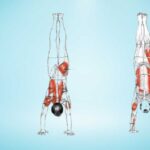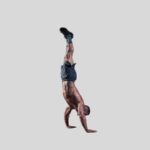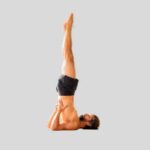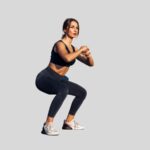Handstands are an impressive skill that requires full-body strength and control to master. While handstands recruit muscles throughout the body, they place particular demands on the shoulders, core, and legs. Understanding what muscles do handstands work can help improve technique and target supplemental strengthening exercises.
Table of Contents
What is a Handstand?
A handstand involves balancing inverted, using just the hands for support, while the arms straighten and the legs extend vertically above the torso. This upside-down posture challenges balance, body awareness, coordination and strength. Common handstand variations include one arm, straddle leg, freestanding, and chest-to-wall handstands. Mastering a proper handstand requires muscle recruitment throughout the body.
What Muscles Do Handstands Work
Shoulders and Arms:
- Deltoids – lift and support body in handstand
- Triceps – locked out straight arms support weight
- Biceps – steady extended arms and control descent
- Forearms – distribute forces through the hands
- Rotator cuff – stabilize mobile shoulder joint
Core:
- Rectus abdominis – flexed abs prevent arching
- Obliques – draw inward to maintain rigid alignment
- Lower back – resists overarching as it supports the torso
Legs:
- Glutes – Extend and align legs vertically
- Quadriceps – straight, stiff legs optimize balance
- Hamstrings – steady and control leg positioning
- Calves – plantar flexion points toes for poise

Related: 11 Effective Techniques For Counterbalance Squat
The Critical Role of the Shoulders
Supporting inverted bodyweight
The deltoids, triceps, and rotator cuff bear the demands of lifting and balancing the body upside down against gravity.
Depressing and stabilising the shoulders
Proper shoulder positioning requires depressing the scapulae down and back to support the shoulders and open the chest.
Preventing injury through mobility
Adequate shoulder flexibility allows proper alignment in the overhead position and prevents impingement or strain.
Engaging the rotator cuff
The rotator cuff stabilizes the shoulder joint throughout the handstand motion to avoid destabilizing the shoulders.
Related: Candlesticks Exercise For True Core Strength

The Importance of Core Activation
Preventing arched lower back
Tight abdominal engagement prevents excessive lower back arching, which can lead to injury.
Drawing ribs inward and engaging abs
Creating core tension by actively drawing the lower ribs while contracting the abdominals locks the torso into proper handstand alignment.
Maintaining a hollow body position
The core must maintain a rigid, hollow body position to support the linear, vertical handstand alignment.
Supporting the linear inverted alignment
Total core activation keeps the body stacked and aligned, preventing destabilising shifts while inverted.
Related: How To Hold A Long Handstand
Glute and Leg Strength for Stability
Extending legs upward with control
Glute strength allows a controlled elevation of extended legs overhead, preventing uncontrolled leg movement.
Maintaining tight vertical leg alignment
Glutes and quadriceps keep legs squeezed together and vertically aligned over hips to optimise balance.
Avoiding uncontrolled leg movements
Sufficient glute strength prevents legs from drifting or separating, which compromises balance.
Enabling transitions like straddle press
Glute and leg power facilitates transitional moves like straddle presses from inverted positions.
Proper Handstand Form to Target Key Muscles
Shoulder placement directly over wrists
Optimal muscle loading requires shoulders stacked over straight wrists when viewed from the side.
Straight elbows fully locked out.
Completely extending elbows engages the triceps to bear weight and maintain rigid arm support.
Open shoulders and chest
Depressed, externally rotated shoulders support body weight while opening the chest.
Tight core and flat back
The hollow body position engages the abdominals maximally while keeping the back flat.
Vertical rigid legs together or straddled
Active glutes and quads extend legs together and point towards the ceiling to maintain balance.
What Muscles Do Handstands Work
Time under tension strengthens fast-twitch fibers
While inverted, sustained isometric tension stimulates strength adaptations, particularly in the upper body.
Isometric contraction of upper body muscles
The sustained shoulder and arm contraction increases muscular endurance.
Resistance training benefits inverted
The inverted posture makes handstands an unusual full-body resistance exercise.
Eccentric control builds supportive strength
Lowering down from a handstand eccentrically loads the muscles to support body control.
Related: Kinematics and joints moments profile during straight arm press to handstand
Additional Exercises to Supplement Handstands
Targeted supplemental training strengthens the weakest links:
- Overhead dumbbell presses – Deltoid and triceps strength
- Wall handstand holds – Shoulder stability and endurance
- Hollow body raises – Isolated core control
- Planche leans – Scapular strength in an inverted position
- Weighted glute bridges – Glute strength and activation
- Pistol squats – Unilateral leg stability and balance
Preventing Injury and Overtraining
Warm up shoulders and wrists thoroughly
Prep joints for the intense demands to minimize strain or impingement risk.
Controlled skill progression over time
Increase handstand duration and complexity gradually to allow supportive strength development.
Adequate rest between training days
Handstands are taxing. Allow recovery time between sessions.
Proper nutrition supports muscle recovery.
Fuel appropriately with protein and quality carbohydrates for muscle repair.
Benefits Beyond Strength Building
Improved balance and coordination
The control required for handstands develops whole-body coordination.
Enhanced body awareness
Kinesthetic awareness improves through the inverted feel.
Boosted confidence
Mastering this skill creates confidence to push limits further.
Full-body tension control
Handstands teach total body control through active muscles.
A Word From Blogzah
In summary, handstands place substantial demand on the shoulders, core, and legs due to the inverted body position. Dedicated supplemental training for these muscle groups can maximise the strength-building potential of handstands. However, the benefits run deeper than building muscle by improving body control, awareness, focus, and confidence. With patience and proper progression, handstands can be a fun, rewarding way to build holistic full-body strength.
FAQs
Are handstands risky?
Handstands do require skill, strength, balance and concentration to perform safely. Start by learning next to a wall or with spotters. Falls or improper form can lead to injury, so progress slowly and don’t push beyond your limits. Those new to handstands or with medical conditions may want to consult a trainer. With practice, handstands can be performed safely.
Do handstands help hair loss?
There is no evidence that doing handstands can help prevent or treat hair loss. Hair loss is often caused by genetics, hormonal changes, medical conditions or medications. Handstands alone are unlikely to impact these underlying factors.
How many times a week should you train handstand?
There is no set guideline for how often to practice handstands. A reasonable goal for most people is 2-3 handstand training sessions per week.
Listen to your body and avoid overtraining which could lead to injury. Gradually increase the duration and frequency of sessions as your strength and balance improve.
Do you need to be strong to do a handstand?
Having adequate upper body, core and shoulder strength can make learning a handstand easier.
But many people are able to learn with practice, by kicking up into the move rather than pushing up with their arms. Go at your own pace and build strength over time.
Are handstands bad for eyes?
There is no evidence that occasional handstands are harmful to eye health. Prolonged handstands may increase eye pressure, so listen to your body and avoid overexertion.
Those with glaucoma or other eye issues should consult their doctor before attempting handstands.
Do handstands help aging?
As we age, handstands can provide benefits, improving strength, balance, coordination, and bone density. In addition, it may also maintain mobility and reduce fall risk.
However, take care to build up gradually and use caution to avoid injury.
Do handstands help your brain?
Some researchers suggest that handstands increase blood flow that may provide brain benefits.
The pose challenges body coordination and balance, helping to improve cognitive function.
However, more studies are needed on handstands. As with any exercise, listen to your body and don’t overdo it.
Does handstand increase height?
No, handstands do not increase height. After early childhood, our height is determined by genetics and natural growth hormones.
Handstands can help build strength, but they do not stimulate further height growth. Proper nutrition and rest during developmental years can maximise your natural height potential.
How long can the average person hold a handstand?
For most beginners, holding a handstand for 5-10 seconds is often a good starting goal.
With consistent practice, the average healthy person can build up to holding a handstand for 30 seconds to 1 minute.
Elite gymnasts and circus performers may hold handstands for several minutes.
















